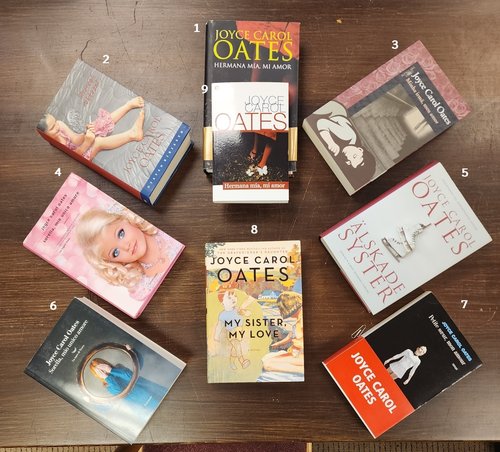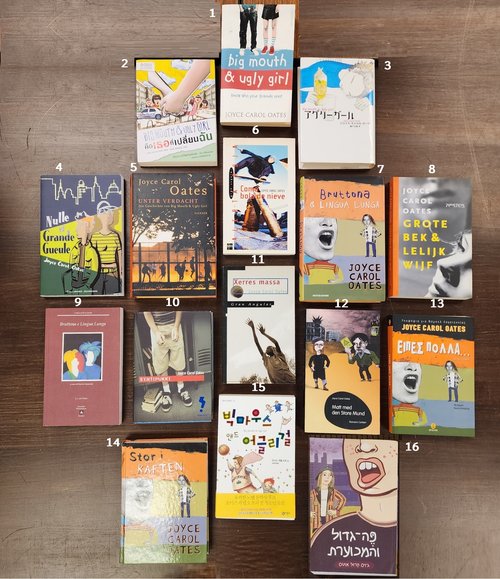Oates in Translation

by Michele Combs, Lead Archivist, SCRC
I’m currently working on the papers of Joyce Carol Oates, award-winning American novelist, poet and teacher. Her published works—some of which appeared under the names Rosamond Smith and Lauren Kelly—have been translated into dozens of languages, and many have been issued in multiple editions over the years. Oates is a Syracuse University alumna, and her papers at SCRC include correspondence, journals, printed material by and about her, and her writings in the form of worksheets, manuscripts, galley proofs, advance reading copies, proof copies and final published editions in English and in translation.
At present, we have identified 762 published volumes of her work in languages other than English. They will eventually go to cataloging and become part of our rare books holdings. In preparation for that, we wanted to sort them based on the original English title, so that all editions of, for example, Oates’ gothic novel The Accursed were together. This was a fascinating exercise! For one thing, determining the original English title was not always straightforward. In some cases, the foreign publisher explicitly stated “Original English title:” or “Originally published as ...” on the copyright page, but in other cases (particularly with older editions) I had to make use of the Google Translate app on my phone. This sometimes took a little additional detective work, since the title of a foreign edition might differ considerably from that of the English edition, or even from other editions in the same language.

Figure 1. Covers for various editions of Double Delight
For example, the novel pictured in Figure 1 was originally published in English under the title Double Delight. One Swedish edition (top right) was titled Dubbel-rosen (Double Rose) and one French edition (bottom left) was titled Double Diabolique. These at least contain the word “double.” However, the other Swedish edition (top center) was titled Sarons Ros (which google was unable to translate accurately) and another French edition (not pictured) was published under the title Fleur vénéneuse (Poisonous Flower). The German edition (top left) is titled Lockender Engel (Alluring Angel) which bears no similarity to the English title and might easily be confused with another novel by Oates, Angel of Light. To top it off, this book was reissued in the US in 1999 under the completely different title Starr Bright Will See You Soon, so that was a fun adventure/mystery/riddle.

Figure 2. Covers for various editions of My Sister, My Love: 1) Spanish; 2) Finnish; 3) Portuguese; 4) Italian; 5) Czech; 6) Italian; 7) French; 8) English; 9) Spanish
Another interesting aspect of the “Big Sort” was seeing the different cover illustrations for the various editions. For example, Figure 2 shows nine editions of My Sister, My Love, Oates’ novel which was inspired by the 1996 murder of child beauty queen JonBenét Ramsay. The Italian edition (4) is clearly referencing Barbie with its pink background and doll-like child’s face. Editions 3 (Portuguese) and 8 (English) feature two children, but 8 shows a peaceful summer-like scene totally at odds with the story, while 3 is much more ominous with one child lying at the bottom of a flight of stairs and the other looming at the top. The Czech and French editions (5, 7) have opted for realistic and fairly neutral images which reference ice skating but don’t offer much in the way of clues about the story. When I glanced briefly at the Finnish edition (2) I thought it was a young girl innocently playing on the beach, but no: she is sitting on a large bed smiling at herself in a mirror, evoking a disturbingly adult ambience. Interestingly, six of the nine covers portray a young girl alone.

Figure 3. Covers for various editions of Big Mouth, Ugly Girl: 1) English; 2) Thai; 3) Japanese; 4) French; 5) German; 6) Spanish; 7) Italian; 8) Dutch; 9) Italian; 10: Finnish; 11) Catalan; 12) Swedish; 13) Greek; 14) Swedish; 15) Korean; 16) Hebrew
The book for which we have the most foreign-language editions, some of which are pictured in Figure 3, is Oates’ young adult novel Big Mouth and Ugly Girl, about high school students Matt and Ursula. Many of the covers depict two young people, sometimes holding hands, evoking the book’s theme of friendship. But the Finnish edition (10) shows only the lower part of a young man and is titled Syntepukki (Scapegoat), signaling the event that begins the novel, when Matt’s casual words are misunderstood by school officials as a bomb threat. Similarly, the Catalan edition (11) shows only a young man playing basketball, and the title is Xerres massa (You talk too much), with no hint of Ursula’s presence. The Japanese (3) and Spanish (6) editions also have only a boy on the cover. The range of styles is interesting too: several are cartoon-like (7, 12, 13-16), presumably to appeal to a younger audience; three are more realistic (1, 2, 4) and five look like actual photographs (5, 6, 8, 10, 11). Interestingly, only the Swedish edition (12) explicitly references the mistaken bomb threat on its cover, via the exploding building in the background.
These differences are interesting both from a purely visual standpoint (color, style, level of realism), but also for what emotions they evoke, and what elements of the story they choose to highlight, suggest, or ignore. Are these choices influenced by the culture of the country where each was published, or are they no more than a reflection of personal taste on the part of the editor? It’s an interesting question.
As a bonus for me personally, as a result of the “Big Sort,” I now know a very small number of words in a very large number of languages!
